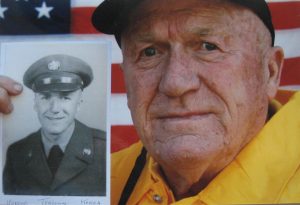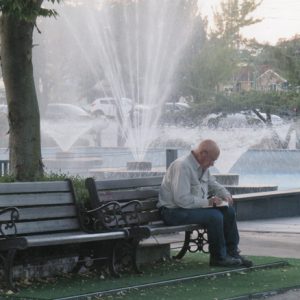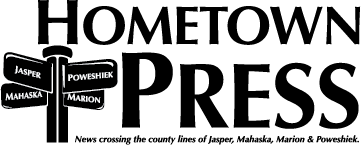After leaving more than 60 years ago, U.S. Army Veteran Vernon Terlouw of rural Killduff recently returned to South Korea, where he had served during the Korean War from 1952-54. He took part in a 10-day tour set up by Military Historical Tours, Inc. based out of Woodbridge, VA. About 50 U.S. veterans took part in the tour to revisit the country after such a long absence.
Terlouw left on Sept. 14, and eventually boarded a flight in Chicago on a Korean Air Lines (KAL) wide body jet for a 12.5-hour non-stop flight, which landed at the $800 million air terminal at Inch’on, South Korea. KAL alone has 27 loading gates at that airport. Inch’on is the same point that was used for Terlouw’s first entry into Korea in 1952, but he now saw quite a difference from when 20-year-old Terlouw and the rest of his fellow 4,000 combat troops arrived after a nearly three-week ocean voyage on a ship called the Freeman. They transferred from the ship to a landing craft, walking onto the beach in mud and wet sand, known as the “mud flats.” He was stunned by this contrast, the first of many differences between the 1950s and 2017 in South Korea.

In 2013 on a Jasper County Freedom Flight, Terlouw holds a picture of himself from 1952. Terlouw served his country during the Korean War. A recent trip to South Korea evoked memories from his time of service over 60 years ago. Terlouw was awarded the Ambassador of Peace medal during his return visit.
Terlouw’s Korean War Service 1952-1954
The Korean War began on June 25, 1950, when the North Koreans invaded South Korea. It officially ended on July 27, 1953, when a ceasefire was called, but no peace treaty has ever been signed. The Korean peninsula is now divided into the two countries of North Korea (Democratic People's Republic of Korea) and South Korea (Republic of Korea). The border between the two countries, also known as the DMZ or Demilitarized Zone, crosses the 38th Parallel from southwest to northeast and is roughly 160 miles long and 2.5 miles wide. North Korea’s northern border is shared with China. Other than its northern border with North Korea, South Korea is surrounded by water, its southern border roughly 120 miles northwest of Japan at its closest point.
Terlouw was drafted into the Army in 1952, and after boot camp, he received training in heavy weapons and mortars at Fort Riley, KS. After his training was completed in 1953, he was immediately sent to Korea. After Terlouw arrived at Inch’on, South Korea, he and his fellow soldiers were issued M1 rifles, helmets, and a can of C-rations.
He shares the story of his first day in Korea: “We then boarded an open-sided, old train car and started our journey across the Han River north to the front, to go as replacements with the 2nd Infantry Division. With my MOS of heavy weapons infantry, special mortars, most of us would not have given a plugged nickel for our chances of staying alive. After our slow train ride in the heat of a Sunday afternoon, we arrived at the front in the middle of the night. We were happy to be out of the heat of the day. There was a tremendous noise of gunfire, and the night sky was full of flames that cast an eerie light all around. They told us where to get water to drink and where we could sleep for the remainder of the night. With the cool night air, I was asleep in a minute in spite of the noise.”
After the ceasefire was called in 1953, Terlouw was transferred from heavy weapon infantry to an MOS in personnel management, and worked at 2nd Division headquarters, located two miles behind the line. The field office was actually a large tent, and he slept in another tent with mosquito netting in the summer and with snow in the winter. But, he took it all in stride: “We were all in it together, and coming from a livestock farm in Iowa, I knew what it was like to be cold, wet, and miserable, standing in the snow eating C-rations out of a can or picking your slice of bread out of the sludge, where the wind had blown it off your canteen and then eating it because no waitress was there to bring another. Some joker could always see something funny in it, and we could laugh.”
Terlouw developed deep friendships with some of the soldiers with whom he served, some of these friendships still in place after 65 years. He received an honorable discharge in 1954 and returned to his former life of farming near Killduff.
South Korea revisited, 2017

Terlouw takes a minute during the tour to journal his thoughts.
And so Terlouw was able to return to South Korea with other Korean War veterans for a firsthand look at how the country has changed since he left in 1954. Terlouw doesn’t consider himself to be any kind of hero, but he was reminded over and over again during the recent trip how much the collective effort of the U.S. military made an incredible difference in the lives of South Koreans today. The graciousness and gratitude of the South Koreans toward the group of U.S. veterans was overwhelming to Terlouw. The South Koreans are so grateful that their country’s democracy was preserved and is intact today, due in large part to the U.S. presence during the Korean War. This is in contrast to North Korea’s current impoverished state. Terlouw was so happy to see healthy, tall South Korean people and the results of a robust economy, compared to the population in 1953, with so many emaciated South Korean children. Today, South Korea is the fourth largest producer of automobiles in the world, including Kia and Hyundai. They have indeed risen from the ashes. The landscape today bears little resemblance to what Terlouw remembers from his days in the service. In fact, one experience he was anticipating never took place. He remembered two distinct smells from South Korea, those of kimchi (fermented cabbage) and burning rice straw, but neither of these was in the air when he arrived in 2017.
Terlouw arrived in Inch’on, South Korea, where he was greeted by his tour guide, Jamie, who hails from Virginia. Terlouw was the only veteran on the KAL flight from Chicago and was surprised by Jamie’s ease in identifying him when he entered the Inch’on terminal. Jamie good-naturedly assured him that he was quite used to doing this and was pretty good at identifying members of his tour groups. Terlouw mentioned to Jamie early in his visit that “this is not Korea,” because of the stark contrast between his memories and what his eyes now beheld. This became a running joke throughout the entire tour. The tour was first-rate with wonderful hotel accommodations, food, the itinerary, and the tour staff. Terlouw didn’t always know what he was eating when the meals included Korean foods, but he said that anything would taste good “when you added enough hot peppers.”
Terlouw said part of the tour was financed by the South Korean government, to show their gratitude for the efforts of the U.S. military who served in the war. This was an emotional trip for everyone who went on the tour. Many veterans, now in their 80s and 90s, were accompanied by family members, but others, including Terlouw, for their own reasons decided to go on the trip alone. Nurses were available on the tour buses to assist anyone who needed help with navigating steps, etc.
Terlouw was one of three veterans who opted to partake in an additional “pre-tour” for a few days, which allowed them to visit several battlefields of the Korean War, including Pork Chop Hill and the Punchbowl. He said other veterans had also originally planned to go on the “pre-tour,” but they decided against it because of the escalating tension between North Korea and the U.S. The pre-tour group also visited the DMZ at the 38th Parallel. The only disappointment Terlouw experi-enced during his trip was he was not able to locate the exact spots where he had been assigned during the war, even with a great deal of assistance from current South Korean soldiers. The landscape had changed too much in 60 years to find anything that looked familiar. Terlouw said he felt like Goldilocks in his quest. Seventy percent of the country consists of mountains and valleys, and each valley he looked at was either “too large” or “too small” to be the valley he remembered.
The tour itinerary included the city of Seoul (which Terlouw compares to Manhattan) and its War Museum. A bronze listing of the thousands of U.S. soldiers who died in the war, organized by state, is part of the museum. Terlouw spent some time there looking at the names of Iowans and left some flowers at the site.
Near the end of their trip, the 50 veterans and their travel companions were invited to a banquet honoring their service, where South Korean representatives reaffirmed their gratitude for the preservation of their democracy through the efforts of the U.S. military in the 1950s. Terlouw and others received medals they had not received when they served in the 1950s, presented by the Minister of Patriots and Veterans Affairs of the Republic of Korea. Terlouw’s medal represented that he was considered an “Ambassador for Peace” as a veteran among his countrymen.
The historians of South Korea are in the process of gathering information, pictures, and stories of the Korean War to put in the War Museum and interviewed the veterans of Terlouw’s group for their input. The first question he was asked was, “What was your worst day in Korea?” But instead, Terlouw wanted to tell them about a moment of extreme happiness: “Such as a warm summer night. In total darkness, with no light of any kind, a match, a flashlight that might attract sniper fire. With no moonlight, we could not see each other’s faces, a wonderful comradery with men from all over America, thrown together by the drama of war. Sitting together on the ground, the men drinking warm beer. We were all so happy that we were alive and just maybe things would not be as bad as we thought. They were getting serious, after two years, on a ceasefire agreement.”
Terlouw returned home from Korea the second time on Sept. 23, with pictures of a new South Korea, new memories, and of course, new friends.
Veterans Day is Saturday, Nov. 11, a day in which we thank and honor those who have selflessly served their country and fought for our freedom. The Hometown Press greatly respects and appreciates all of those who have honorably served in the U.S. military and it is why we are excited to launch a new series, Serving U.S. This monthly feature aims to share the service of local veterans with our readers. Whether they served decades ago or are actively serving, we want to share their experiences. We value our readers’ input – if you or someone you know should be featured, please contact us at 641-594-3200 or press@netins.net.



